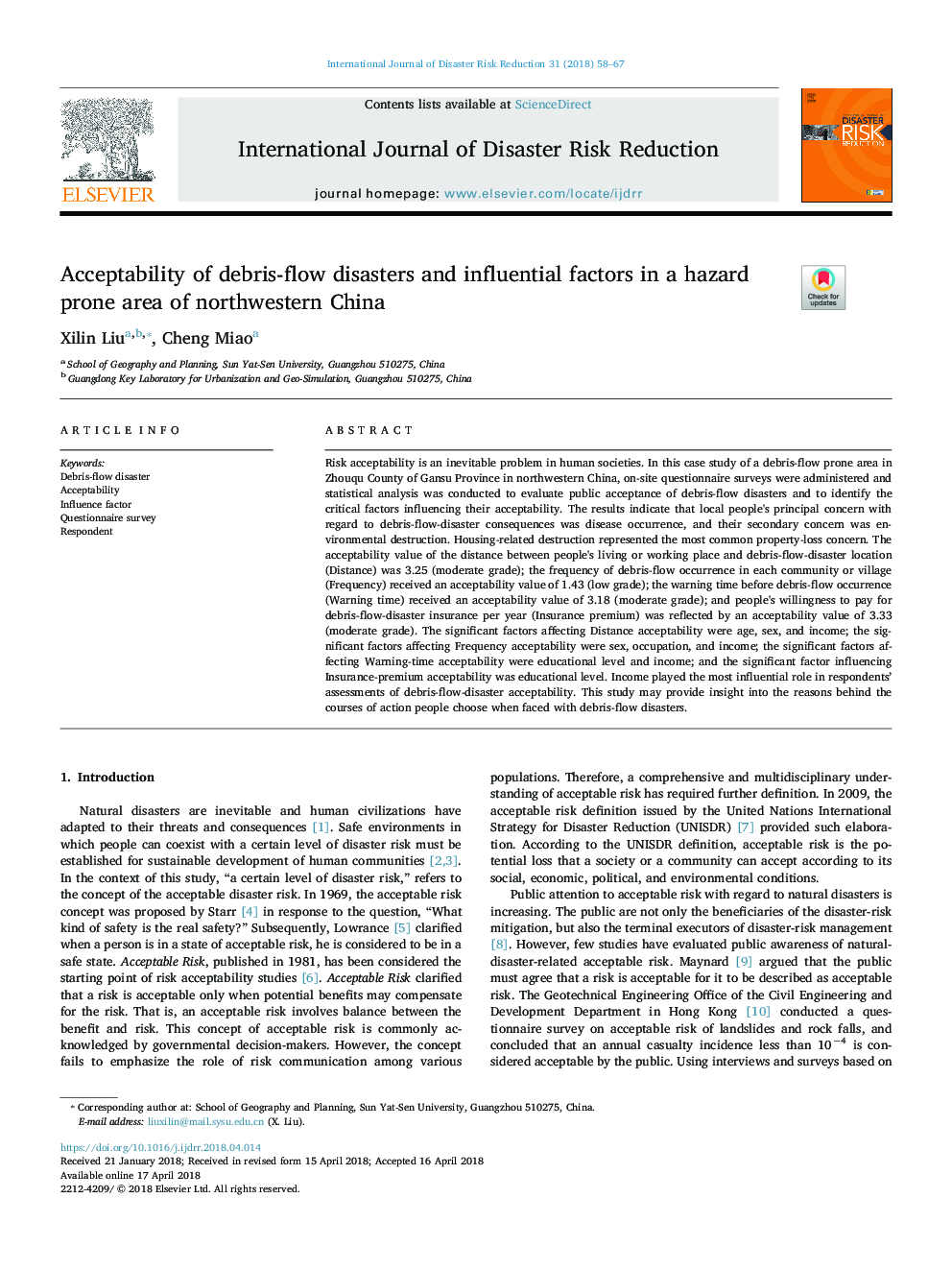| کد مقاله | کد نشریه | سال انتشار | مقاله انگلیسی | نسخه تمام متن |
|---|---|---|---|---|
| 7470993 | 1485138 | 2018 | 10 صفحه PDF | دانلود رایگان |
عنوان انگلیسی مقاله ISI
Acceptability of debris-flow disasters and influential factors in a hazard prone area of northwestern China
ترجمه فارسی عنوان
پذیرش بلایای جریان جریانی و عوامل تاثیرگذار در یک منطقه خطرناک در شمال غربی چین
دانلود مقاله + سفارش ترجمه
دانلود مقاله ISI انگلیسی
رایگان برای ایرانیان
کلمات کلیدی
فاجعه جریان انباشته، پذیرش، عامل تاثیرگذار، پرسش نامه، پاسخ دهنده،
ترجمه چکیده
پذیرش ریسک یک مشکل اجتناب ناپذیر در جوامع انسانی است. در این مورد مطالعه موردی منطقه مستعد جریان انقباض در شهرستان ژووک استان گانسو در شمال غربی چین، بررسی های انجام شده در محل پرسشنامه انجام شد و تجزیه و تحلیل آماری برای ارزیابی پذیرش عمومی از بلایای جریان جوی و شناسایی عوامل مؤثر بر آن ها انجام شد پذیرش نتایج نشان می دهد که نگرانی اصلی مردم در ارتباط با پیامدهای فاجعه بقایای بقایای بقایای بیماری، وقوع بیماری بوده و نگرانی دوم آنها نابودی محیط زیست است. تخریب مربوط به مسکن نشان دهنده شایع ترین نگرانی از دست دادن اموال است. ارزش قابل قبول فاصله بین محل زندگی یا محل کار و محل فاجعه جابجایی (فاصله) 3.25 (درجه متوسط) بود؛ فراوانی رخداد جریانی جریان در هر جامعه یا روستا (فرکانس) ارزش پذیرایی 1.43 (درجه پایین) را دریافت کرد؛ زمان هشدار قبل از وقوع حادثه (زمان اخطار) ارزش پذیرش 3.18 (درجه متوسط)؛ و تمایل مردم برای پرداخت هزینه های ناشی از جابجایی فاجعه در سال (حق بیمه) با ارزش قابل قبولی 3.33 (درجه معتبر) منعکس شد. عوامل موثر بر پذیرش از راه دور عبارت بودند از سن، جنس و درآمد؛ عوامل مؤثر بر پذیرش فرکانس عبارت بودند از: جنس، شغل و درآمد؛ عوامل موثر بر پذیرش زمان اخطار، سطح تحصیلات و درآمد بود؛ و عامل مهمی که بر پذیرفتن بیمه حق بیمه تأثیر می گذارد، سطح تحصیلات است. درآمد نقش مهمترین نقش را در ارزیابی پاسخ دهندگان به جبران هزینه های فرسایشی داشت. این مطالعه ممکن است بینش هایی را در مورد علل دوره های عمل افراد مطرح کند، زمانی که با بلایای جریان انبوه مواجه می شوند.
موضوعات مرتبط
مهندسی و علوم پایه
علوم زمین و سیارات
فیزیک زمین (ژئو فیزیک)
چکیده انگلیسی
Risk acceptability is an inevitable problem in human societies. In this case study of a debris-flow prone area in Zhouqu County of Gansu Province in northwestern China, on-site questionnaire surveys were administered and statistical analysis was conducted to evaluate public acceptance of debris-flow disasters and to identify the critical factors influencing their acceptability. The results indicate that local people's principal concern with regard to debris-flow-disaster consequences was disease occurrence, and their secondary concern was environmental destruction. Housing-related destruction represented the most common property-loss concern. The acceptability value of the distance between people's living or working place and debris-flow-disaster location (Distance) was 3.25 (moderate grade); the frequency of debris-flow occurrence in each community or village (Frequency) received an acceptability value of 1.43 (low grade); the warning time before debris-flow occurrence (Warning time) received an acceptability value of 3.18 (moderate grade); and people's willingness to pay for debris-flow-disaster insurance per year (Insurance premium) was reflected by an acceptability value of 3.33 (moderate grade). The significant factors affecting Distance acceptability were age, sex, and income; the significant factors affecting Frequency acceptability were sex, occupation, and income; the significant factors affecting Warning-time acceptability were educational level and income; and the significant factor influencing Insurance-premium acceptability was educational level. Income played the most influential role in respondents' assessments of debris-flow-disaster acceptability. This study may provide insight into the reasons behind the courses of action people choose when faced with debris-flow disasters.
ناشر
Database: Elsevier - ScienceDirect (ساینس دایرکت)
Journal: International Journal of Disaster Risk Reduction - Volume 31, October 2018, Pages 58-67
Journal: International Journal of Disaster Risk Reduction - Volume 31, October 2018, Pages 58-67
نویسندگان
Xilin Liu, Cheng Miao,
